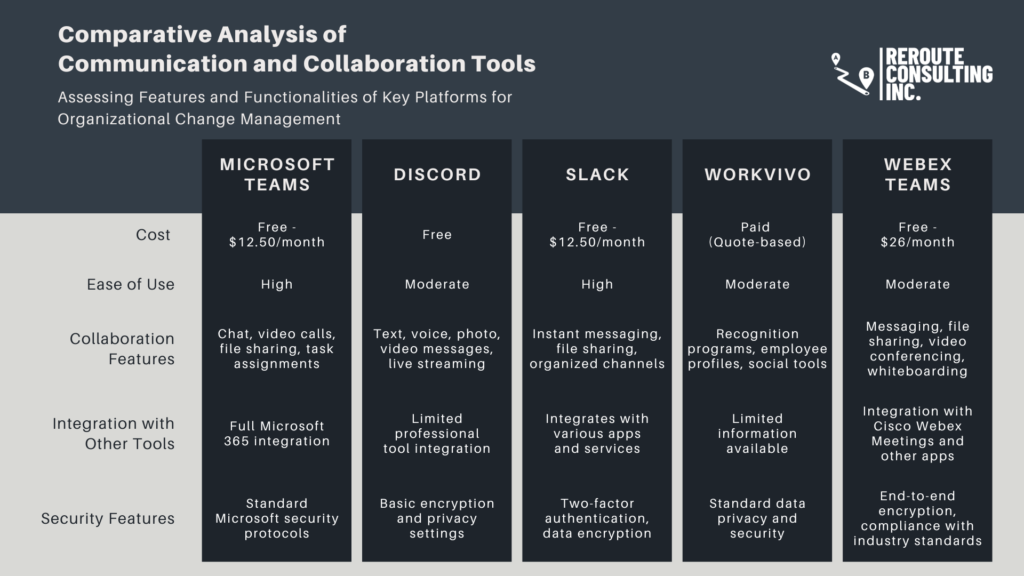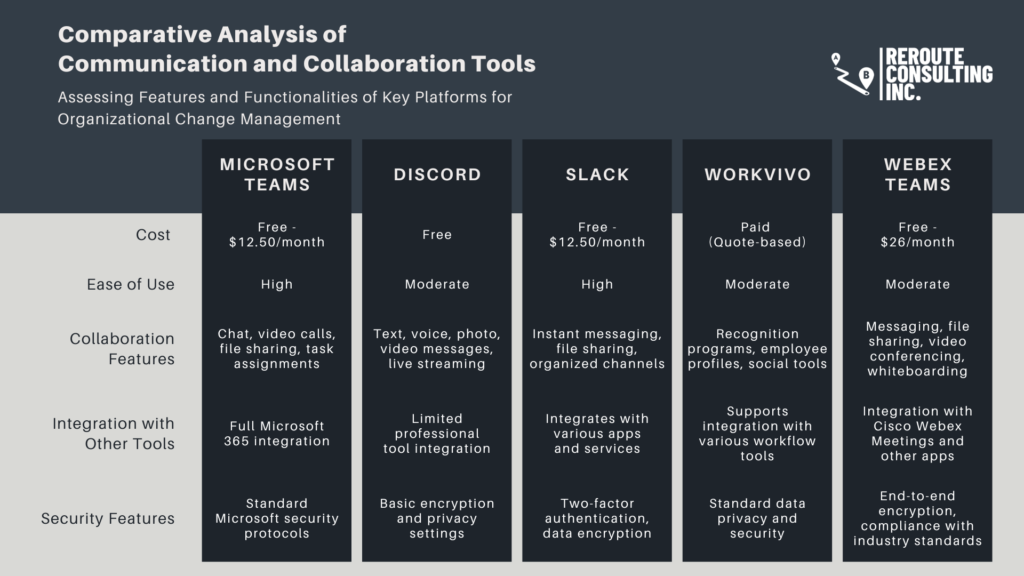Embracing new media formats for communicating change fosters greater collaboration, boosts engagement, and mitigates resistance from team members. While emails remain valuable, they should be used judiciously for effectiveness. The key lies in selecting suitable communication methods based on specific objectives and the target audience, ensuring relevant colleagues are included or tagged. Accommodating the communication preferences of employees and team members is vital, as some may prefer traditional channels while others engage more with newer media. Leveraging these media for change communication helps keep employers and employees informed about work and changes without disrupting the workflow.

Comparative Analysis of Communication and Collaboration Tools
Microsoft Teams
Microsoft Teams, part of the Microsoft 365 suite, is designed to facilitate communication and collaboration, especially for remote or distributed teams.
Cost: Options range from free to monthly subscriptions (Microsoft Teams Essentials at $4/month, Microsoft 365 Business Basic at $6/month, and Microsoft 365 Business Standard at $12.50/month).
Pros:
- User-Friendly Interface: Known for its ease of use and familiar layout, especially for those already using Microsoft products.
- Full Integration with Microsoft 365: Seamless compatibility with Microsoft Office tools like Word, Excel, and PowerPoint.
- External Collaboration: Allows guest access, facilitating collaboration with users from other organizations.
- Diverse Communication Options: Includes chat, video calls, and task management features.
Cons:
- Limited External User Functionality: External users may face restricted capabilities compared to internal users.
- Notification Overload: Can generate a significant number of notifications, potentially leading to information overload.
- Navigation Complexity: Some features, like accessing recordings, can be less intuitive and require navigating through various tabs.
Summary
Microsoft Teams is an excellent choice for organizations deeply integrated with Microsoft 365. It is particularly useful for project launches, corporate communications, and real-time collaboration through chat and video. However, its performance can be demanding on system resources, and navigating some of its features might require a learning curve. It is most effective in transformational and transitional change management scenarios.
Discord
Discord is a chat app allowing users to create private servers with multiple channels for text, voice, photo, or video messages.
Cost: Free
Pros:
- Community Building: Ideal for creating spaces with various interest channels, enhancing community interaction.
- Live Streaming Capabilities: Offers the ability for live streaming to a server audience.
- Diverse Interaction Methods: Supports voice, video calls, and live chat boxes for real-time engagement.
Cons:
- Gaming Association: Primarily designed for gaming communities, which might not align with all professional environments.
- Complex Interface: Can be overwhelming for new users due to its many features and functionalities.
- Limited Professional Tools: Does not offer built-in task management or business-oriented tools.
Summary
Discord is an excellent tool for quick, continuous collaboration and is especially beneficial in times of remote work and dynamic project environments. It is best suited for developmental change management, such as in projects focused on continuous improvement, team development, and problem-solving.
Slack
Slack is a centralized platform for team communication, collaboration, and file sharing, popular in professional settings.
Cost: Free and Paid options (Slack Pro at $7.25/month, Business+ at $12.50/month).
Pros:
- Real-Time Communication: Facilitates instant messaging and quick connections between team members.
- Robust Security: Implements measures like two-factor authentication and data encryption.
- File Sharing and Integration: Supports various file types and integrates with cloud storage and other services.
- Organized Conversations: Uses channels to help organize discussions by topic or project.
Cons:
- Information Overload: The constant message flow can lead to distractions and overwhelm.
- Initial Complexity: New users might find the interface and features a bit daunting at first.
- Dependency on Internet Connectivity: Requires a stable internet connection for optimal performance.
Summary
Slack is particularly effective for teams needing a fast, reliable communication platform with strong file-sharing capabilities. It is well-suited for developmental change management, facilitating enhanced sales, quality improvements, and team collaboration. Its integration with various apps makes it a versatile tool for centralized communication.
Workvivo
Workvivo is a Zoom powered platform designed to connect and engage employees, improving organizational communication.
Cost: Paid (requires a sales quote)
Pros:
- Comprehensive Collaboration Tools: Offers messaging, file sharing, video conferencing, and whiteboarding.
- Seamless Integration: Integrates with Cisco Webex Meetings for smooth transitions between messaging and video conferencing.
- Strong Emphasis on Security: Features end-to-end encryption for messaging, secure file sharing, and compliance with industry standards.
- Scalability: Designed to meet the needs of both small teams and large enterprises.
- Third-Party Application Integration: Supports integration with various workflow tools to enhance productivity.
- Employee Engagement Features: Includes recognition programs, employee profiles, and social interaction tools.
- Customization Options: Allows organizations to tailor the platform to their specific needs and branding.
- Integration with Other Tools: Provides a seamless user experience through integration with various systems.
- Mobile Accessibility: Offers mobile apps for connectivity on the go.
Cons:
- Cost Consideration: Depending on the organization’s size and required features, the cost could be significant.
- Potential Resistance to Adoption: Employees comfortable with existing methods may resist the introduction of a new tool where comparative tools already exist.
- Privacy Concerns: Sharing information within the organization raises questions about data security.
- Integration with Third Party platforms: While possible, it is not straightforward to implement. The platform works best in an organization that uses Zoom as their primary virtual meeting tool.
Summary
Workvivo excels in creating a collaborative platform that respects individual identity and contributions, focusing on intrinsic motivators. It is ideal for scenarios where enhancing sales, quality, and team development are key objectives. Its emphasis on intrinsic motivation makes it a valuable tool for developmental change management, especially in remote work environments.
Cisco Webex Teams
Cisco Webex Teams supports real-time and asynchronous communication, suitable for remote teams.
Cost: Free and paid options (Webex Starter at $19/month, Webex Business at $26/month).
Pros:
- Comprehensive Collaboration Tools: Offers messaging, file sharing, video conferencing, and whiteboarding.
- Seamless Integration: Integrates with Cisco Webex Meetings for smooth transitions between messaging and video conferencing.
- Strong Emphasis on Security: Features end-to-end encryption for messaging, secure file sharing, and compliance with industry standards.
- Scalability: Designed to meet the needs of both small teams and large enterprises.
- Third-Party Application Integration: Supports integration with various workflow tools to enhance productivity.
Cons:
- Learning Curve: The platform’s various features and functionalities may initially be complex for some users.
- Resource-Intensive: Can be demanding on devices with limited processing power, especially during video conferencing.
- Limited Customization: May not offer extensive customization options for interface appearance and organization.
- User Experience: Streamlining the interface for simplicity could be challenging for those seeking an intuitive user experience.
- Integration with Third Party platforms: While possible, it is not straightforward to implement. The platform works best in an organization that uses WebEx as their primary virtual meeting tool.
Summary
Cisco Webex Teams is a versatile platform that combines calling, meeting, messaging, polling, and events. It includes People Insights, a feature providing anonymized data around meetings to help managers gauge team engagement and collaboration dynamics. Positioned between Zoom and Microsoft Teams, Webex integrates more than the former but doesn’t encompass an all-in-one productivity tool like the latter. It is particularly effective for transformational and transitional change management, facilitating detailed discussions on change and supporting necessary calls and meetings.
Navigating change is an inherently complex and imperfect process, often met with varying degrees of acceptance among employees. However, the manner in which organizations communicate these changes can play a pivotal role in shaping employee perceptions and responses. By thoughtfully selecting and utilizing communication platforms that align with a company’s values and culture, there’s potential to foster a more open and receptive attitude towards change. This approach can encourage employees to not only accept change but also actively contribute positively to the evolving dynamics of the team and organization.
We recognize that the landscape of communication tools is diverse and constantly evolving. As such, we are curious to learn about your experiences and perspectives: What adjustments do you find critical in communicating organizational changes? Your insights are valuable, and we invite you to share them in the comments section. Let’s continue this conversation and exchange ideas on platforms like Twitter and LinkedIn, where we can collectively explore effective strategies for managing change in our workplaces.
Resources:
Comparative Analysis of Communication and Collaboration Tools
Assessing Features and Functionalities of Key Platforms for Organizational Change Management



